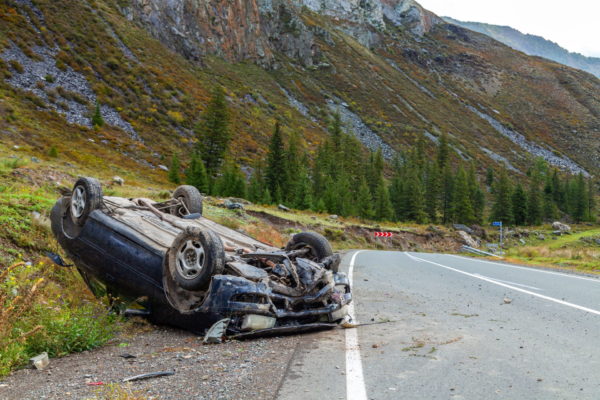A vehicle is said to have had a rollover accident when it tips on its side or roof. It might end up back on its wheels, but as the wheels have a lot more friction than the road, often it’ll roll more if it’s managed to do at least one complete revolution.
All types of vehicle can roll – cars, tractors, trucks and agricultural machinery, even motorbikes can have a ‘highside‘ accident which results in a roll.
Which vehicles are most susceptible to rolling?
Vehicles with a high centre of gravity are most at risk of rolling. This usually means that they are tall with a heavy load. Car transporters, flat-deck trailers carrying heavy machinery and tankers containing liquid are very susceptible. In the case of a car transporter or a flat-deck carrying machinery, the trailer is relatively light, but the cars are loaded high. With a tanker, the load is quite high and the liquid sloshing around can tip the trailer over. High-sided vehicles are also at risk of strong sidewinds.
If a load is loose and can move independently of the vehicle, this can cause enough extra momentum to tip a vehicle.
Cars and SUVs can be tipped over if a trailer begins to fishtail due to driving too fast. Eventually, this causes a jackknife. There are ways of stopping a trailer swaying.
Buses can be at risk, particularly double-deckers with many people on the top deck.
Quad bikes, light utility vehicles and tractors are involved in many farm accidents, usually when being driven on a side-slope.
Vehicles with a low centre of gravity are much harder to roll but, as we’ll see, not impossible.
What type of roads make rollovers more likely?
A vehicle just needs enough angle or momentum to cause it to tip. Road design contributes to this.
Roundabouts and chicanes
When a vehicle changes directions suddenly, weight is shifted from one side to the other and the pendulum effect can cause it to tip over, even at very low speed. Roundabouts and chicanes are areas where this direction change happens within a short space of time, but even left-right or right-left corner combinations on the open road can cause this.
Adverse camber
When driving around a bend, a vehicle is already leaning towards the outside of the curve due to centrifugal force compressing the suspension and tyres. When a road’s surface slopes towards the outside of a bend, the vehicle leans even more. For high-sided vehicles, this can cause a rollover; it’s unlikely to cause a rollover in a car as the tyres are more likely to slide sideways on the tarmac first.
Sidewinds in exposed areas
Wind funnels down valleys, so bridges that cross them can be subject to high sidewinds. High winds can also occur on coastal roads and open plains.
Change in road surfaces
If you’re turning and there’s a bump in the middle of the corner, this can tip a high-sided vehicle that is already on the verge of tipping.
A kerb can catapult a vehicle upwards, as can barriers.
A sudden slippery spot can cause a vehicle to spin out which, if it then hits soft ground or a low object to act as a ramp, will cause a rollover.

Verges
Unmown verges can hide dips, drop-offs and subsidence into ditches that can catch drivers out who pull onto them – something more risky when it’s a narrow country lane.
Vehicle’s parked on the verge can cause it to collapse.
What type of driving increases the risk of a rollover crash?
Rapid change in direction: if a driver has to swerve around something, this can cause weight transfer from side-to-side leading to a rollover. Most modern vehicles have some kind of electronic stability control to help prevent this, but some SUVs are still susceptible to rolling, and rigid trucks (which don’t usually have stability control) are at high risk. In fact, the ‘moose test’ checks whether a vehicle will survive this kind of manoeuvre.
Off-road vehicles have been known to roll backwards while trying to drive up a slope that’s too steep. Side-slopes, as mentioned previously, are risk factors. Any more than around 33% tilt is likely to cause the vehicle to roll.
Collisions with other objects can tip a vehicle over, especially if their wheels touch (you can sometimes see the dramatic effect of this if two Formula 1 cars touch wheels)
Overcorrection, where a vehicle starts sliding one way then the driver overcorrects, can be the start of losing control where the vehicle either then digs in or is blocked at the wheels (e.g. by soft ground or a kerb), or the rapid change in direction causes the rollover.
Cornering too quickly is a risk for lorries. Cars will tend to slide, but lorries have a lot of rubber in contact with the road, plus a high centre of gravity.
How does a driver reduce rollover risk?
Mainly it’s a case of slowing down enough when cornering. Look further ahead so that things don’t surprise you. Truck drivers must make sure that their load is secure.
How can road design reduce rollover risk?
- Ensuring corners have positive camber rather than adverse camber make cornering performance more reliable.
- Severe bumps in corners should be engineered out. Chicanes should be avoided.
- Mini roundabouts and roundabouts need clear signage and plenty of room for manoeuvring.
- Recommended speeds should be posted on dangerous corners.
